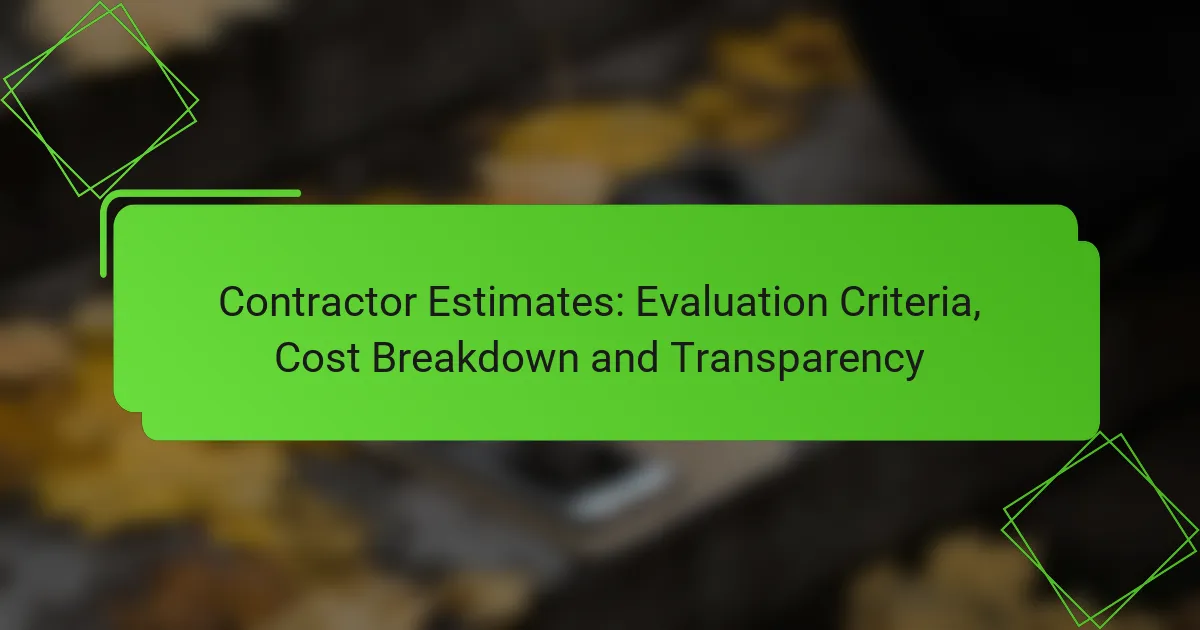Evaluating contractor estimates is essential for ensuring that your project aligns with both your needs and budget. By examining detailed proposals, clients can assess key factors such as scope of work, contractor qualifications, and compliance with local regulations. Understanding the cost breakdown, including labor rates and material expenses, promotes informed decision-making and effective budget management. To enhance transparency, it’s crucial to request detailed cost information and compare multiple bids to avoid unexpected expenses.

How to evaluate contractor estimates in Ireland?
Evaluating contractor estimates in Ireland involves comparing detailed proposals to ensure they meet your project needs and budget. Key factors include the scope of work, contractor qualifications, project timelines, and compliance with local regulations.
Consider project scope and specifications
Clearly defining the project scope and specifications is crucial for accurate estimates. Ensure that all aspects of the work, including materials, labor, and any special requirements, are detailed in the estimate.
For example, if you are renovating a kitchen, specify the type of cabinets, countertops, and appliances you want. This clarity helps prevent misunderstandings and ensures that all contractors are bidding on the same project parameters.
Assess contractor experience and reputation
Evaluating a contractor’s experience and reputation can significantly impact the quality of your project. Look for contractors with a solid track record in similar projects and positive reviews from previous clients.
Check online platforms, such as Trustpilot or local forums, for feedback. Additionally, ask for references and follow up with past clients to gauge their satisfaction and the contractor’s reliability.
Review timelines and deadlines
Timelines and deadlines are essential components of contractor estimates. Ensure that the proposed schedule aligns with your expectations and project needs.
Discuss potential delays and how they will be managed. A good contractor should provide a realistic timeline that includes milestones for completion, helping you track progress throughout the project.
Check for required permits and regulations
In Ireland, certain projects require permits and must comply with local building regulations. Ensure that the contractor includes the cost and responsibility for obtaining necessary permits in their estimate.
Familiarize yourself with local regulations, as failure to comply can lead to fines or project delays. A reputable contractor should be knowledgeable about these requirements and guide you through the process.

What factors influence contractor estimate costs?
Contractor estimate costs are influenced by various factors including labor rates, material costs, and the complexity and size of the project. Understanding these elements can help clients make informed decisions and manage their budgets effectively.
Labor rates in Dublin
Labor rates in Dublin can vary significantly based on the type of work and the skill level required. For instance, skilled tradespeople such as electricians and plumbers may charge higher hourly rates compared to general laborers. On average, hourly labor costs can range from €20 to €50, depending on experience and demand.
When evaluating labor costs, consider the duration of the project and the number of workers needed. Hiring a contractor with a transparent pricing structure can help avoid unexpected expenses.
Material costs in Ireland
Material costs in Ireland fluctuate based on market conditions, availability, and the specific materials required for the project. Common construction materials like concrete, timber, and steel have seen price variations due to supply chain issues and increased demand. It’s wise to budget for potential increases, as material costs can account for a significant portion of the overall project estimate.
To get a clearer picture, request a detailed breakdown of material costs from your contractor. This will help you understand where your money is going and allow for better comparisons between estimates.
Project complexity and size
The complexity and size of a project directly impact contractor estimates. Larger projects typically require more resources, time, and coordination, which can increase costs. For example, a simple renovation may be less expensive than a full-scale construction project, which involves multiple trades and permits.
When assessing project complexity, consider factors such as design intricacies, the need for specialized labor, and regulatory requirements. Clear communication with your contractor about your project’s scope can help ensure accurate estimates and avoid costly surprises.

How to ensure transparency in contractor estimates?
To ensure transparency in contractor estimates, request detailed information about costs, compare multiple bids, and inquire about potential hidden fees. This approach helps you understand what you’re paying for and prevents unexpected expenses.
Request detailed breakdown of costs
When receiving a contractor estimate, ask for a detailed breakdown of costs. This should include labor, materials, permits, and any other expenses. A clear itemization allows you to see where your money is going and helps identify any areas where costs may be inflated.
For example, if a contractor quotes $10,000 for a renovation, request specifics like $4,000 for materials, $5,000 for labor, and $1,000 for permits. This transparency can help you make informed decisions and negotiate better.
Compare multiple estimates
Comparing multiple estimates is crucial for ensuring you receive a fair price. Aim to gather at least three estimates from different contractors to understand the market range for your project. This practice not only highlights discrepancies but also provides leverage in negotiations.
When comparing, focus on the scope of work, materials specified, and timelines. A lower estimate might not always be the best choice if it compromises quality or service. Look for value rather than just the lowest price.
Ask about contingencies and hidden fees
Inquire about contingencies and any potential hidden fees before signing a contract. Contractors may include a contingency percentage, typically around 10-20%, to cover unforeseen expenses. Understanding this upfront can prevent budget overruns later.
Additionally, ask if there are any fees not included in the initial estimate, such as disposal costs or travel expenses. Clarifying these details ensures you have a complete picture of the financial commitment involved in your project.

What are common pricing models for contractor estimates?
Common pricing models for contractor estimates include fixed-price contracts, time and materials contracts, and cost-plus contracts. Each model has its own advantages and considerations, impacting how costs are calculated and managed throughout a project.
Fixed-price contracts
Fixed-price contracts involve a set price for the entire project, regardless of the actual costs incurred. This model is beneficial for projects with well-defined scopes, as it provides budget certainty for clients.
However, if unexpected issues arise, the contractor absorbs the additional costs, which can lead to lower quality or rushed work. It’s crucial to ensure that the project specifications are clear and comprehensive to avoid disputes.
Time and materials contracts
Time and materials contracts charge clients based on the actual time spent on the project and the materials used. This model is ideal for projects where the scope is uncertain or likely to change, allowing flexibility in adjustments.
Clients should be aware that costs can escalate quickly if the project takes longer than anticipated. To manage expenses, it’s advisable to set a budget cap or regularly review progress and costs with the contractor.
Cost-plus contracts
Cost-plus contracts reimburse contractors for their actual costs plus a predetermined fee or percentage. This model ensures that contractors are compensated for their expenses while providing transparency in pricing.
However, clients should monitor costs closely to avoid excessive spending. Establishing a clear agreement on what constitutes reimbursable costs and setting limits on the contractor’s markup can help maintain budget control.

What are the benefits of detailed contractor estimates?
Detailed contractor estimates provide clarity on project costs and scope, enabling better financial planning and decision-making. They help both clients and contractors understand expectations, which can lead to smoother project execution.
Improved budget management
Having a detailed estimate allows clients to allocate funds more effectively, ensuring that all aspects of the project are financially covered. This transparency helps in identifying potential cost overruns early, allowing for adjustments before they escalate.
For example, a contractor might break down costs into categories like materials, labor, and permits. This breakdown can help clients see where their money is going and make informed choices about where to cut costs if necessary.
Clear expectations for project delivery
Detailed estimates set clear expectations regarding timelines and deliverables, which is crucial for successful project management. Clients can see when specific phases of the project will be completed, helping them plan accordingly.
When both parties agree on the scope and timeline outlined in the estimate, it minimizes misunderstandings and ensures everyone is on the same page. This clarity can enhance communication throughout the project.
Reduced risk of disputes
With a comprehensive estimate, the likelihood of disputes decreases significantly. When costs and project details are documented, both parties have a reference point to resolve any disagreements that may arise.
For instance, if unexpected expenses occur, having a detailed estimate allows for easier discussions about adjustments. This can prevent conflicts and foster a more collaborative working relationship between clients and contractors.

How to choose the right contractor in Ireland?
Choosing the right contractor in Ireland involves evaluating their experience, reputation, and cost estimates. It’s essential to compare multiple bids and ensure transparency in pricing to make an informed decision.
Evaluation Criteria
When evaluating contractors, consider their qualifications, past projects, and client reviews. Look for contractors who are registered with relevant bodies, such as the Construction Industry Federation (CIF) in Ireland, which can indicate professionalism and adherence to industry standards.
Additionally, assess their communication skills and responsiveness. A contractor who is easy to reach and provides clear answers is more likely to deliver a positive experience throughout the project.
Cost Breakdown
A detailed cost breakdown is crucial for understanding how your budget will be allocated. Request itemized estimates that include labor, materials, permits, and any additional fees. This transparency helps prevent unexpected costs later on.
For example, a typical home renovation in Ireland might range from €1,000 to €1,500 per square meter, depending on the complexity and quality of materials used. Ensure that the contractor explains each line item in the estimate.
Transparency
Transparency in a contractor’s pricing and processes fosters trust and reduces the likelihood of disputes. Ensure that the contractor provides a clear timeline for the project, including milestones and payment schedules.
Ask for references and check their previous work to confirm their reliability. A contractor who is open about their methods and willing to share past successes is often a safer choice for your project.



